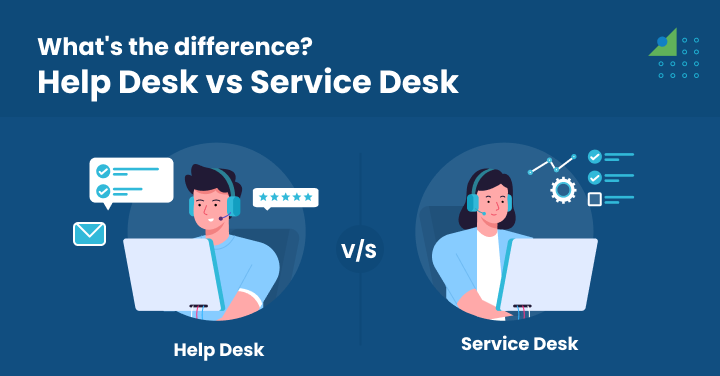Did you know, on average, a company creates approx. 17,630 tickets per month? Just imagine how much the IT support technicians would need to handle daily requests. Even if we track the statistics of a specific industry, the IT service desk is often flooded with user support tickets and repetitive requests related to device troubleshooting, password resets, etc. There are no end-to-customer support needs unless the issues are resolved early. Many ticket creations generally indicate that customers are having difficulty using your product or services.
Further, many requests received in a day can frustrate end users due to long waiting hours. On the one hand, where IT agents feel drowned in performing repetitive tasks, end users feel dissatisfied due to delays in getting solutions to their problems.
This is not a small problem, as each ticket costs time, money, and resources. Remember, the more time your team spends solving avoidable issues, the less time they will have to invest in strategic work or complex problem-solving.
We are talking about a knowledge base that empowers users and employees to find solutions to their IT problems independently. Thus, IT teams can work more efficiently and smoothen daily workflows.
In this blog, we have highlighted some of the major reasons behind the need for a knowledge base for modern IT service desks and listed a few best practices for building a successful knowledge base.
What is a Knowledge Base?
In IT service management (ITSM), a knowledge base is a centralized information repository that users and employees can easily search. It is a dynamic resource that covers how-to guides, troubleshooting articles, step-by-step procedures, setup documentation, FAQs, video tutorials, and other information that helps resolve queries without direct support.
Some of the key components of an effective knowledge base include:
- Well-Organized Structure: The information provided in this system is easy to navigate and grouped by topics or categories for IT teams and end users.
- Search Functionality: It enables users to find relevant information easily using keywords or phrase searches.
- User-Friendly Interface: The intuitive design and easy-to-read formatting help improve user experience and accessibility.
- Content Quality: The knowledge base systems’ guides, articles, and documentation are comprehensive, accurate, and regularly updated.
- Feedback Mechanism: It comes with a feedback system that helps users rate and suggest changes to the available information—content, articles, and documentation. Using this core component, users can even request new articles.
Why Your IT Service Desk Needs a Knowledge Base
From troubleshooting login issues to resolving connection problems, service desk teams cover a wide range of user service requests daily for business continuity and productivity. But as businesses grow or become more complex with new technologies, IT service desks face the burden of handling hundreds of tickets and meeting rising user expectations.
A knowledge base system is crucial as it becomes a valuable resource. Let’s learn how having a knowledge base for the IT service desk can be beneficial:
Reason 1: Reduced Ticket Volume
Users can find solutions to their problems independently with quick access to tutorials or guides. Thus reducing the need to raise a request or create a support ticket. A knowledge base is an excellent tool that companies can add to reduce the number of support ticket submissions.
When users get answers to their fundamental problems by searching the topic or keyword in the system, there is no reason to contact the IT support team.
This self-service system will result in only a few ticket creations. In fact, according to a report, companies that integrated a well-maintained knowledge base system noticed a reduction in customer support tickets by up to 23%. This drop in the traffic volume figure has not only helped lighten the burden on the IT service desk team but also led to more satisfied users.
Reason 2: Improved First-Call Resolution (FCR)
Earlier, remembering steps and quick procedures for the incoming problem was a big challenge for service desk agents. Sometimes, specific requests took longer to resolve. With a knowledge base system, the time delay caused by resolving problems has been decreased.
The knowledge base provides agents with accurate, step-by-step procedures and troubleshooting guides faster. Instead of sticking to a specific problem for too long, agents can solve it immediately.
First-call resolution (FCR) is one of the key performance indicators that help measure the number of tickets resolved during the user’s first contact without the need for follow-up. Higher FCR denotes better user satisfaction and operational efficiency. Further, it implies reduced resolution time and resources spent on each ticket.
Reason 3: Increased User Self-Service
Users often expect convenience and speed from any service. A self-service portal fulfills this demand by enabling users to find solutions without waiting in a support queue. Whether you need steps for troubleshooting or a how-to guide, you can access it anytime and from anywhere.
This convenient and accessible self-service portal empowers users to resolve issues on their terms. Further, with fewer tickets, agents can focus on other important tasks and improve productivity.
Reason 4: Faster Resolution Times
A knowledge base can help users and service desk agents find solutions more quickly. Instead of manually searching through emails or asking teammates for a suitable solution, agents can retrieve the relevant document from the knowledge base and provide a quick solution. Users can also search for appropriate topics or keywords in these systems and access the correct information without opening a ticket.
This acceleration in issue resolution helps solve problems faster, less impacting business operations. Further, fast response builds trust and enables IT teams to handle more requests in less time.
Reason 5: Improved Agent Productivity
Apart from helping users, a knowledge base comes with various other benefits, such as enhancing the productivity of your service desk agents.
By gaining access to documented procedures and step-by-step guides at your fingertips, agents need to spend less time resolving a query. This further helps them tackle complex issues faster and collaborate on strategic tasks. Improved morale, reduced burnout, and better use of IT resources benefit an empowered team.
Reason 6: Consistent Information and Support
IT support has always found it challenging to deliver accurate and up-to-date information to users earlier, regardless of which agent they speak to. However, a centralized knowledge base eliminates discrepancies by serving as a single source of truth.
Whether you want steps to install specific software or reset passwords, the information is now more consistent and reviewed.
This consistency helps reduce confusion, improves compliance, and reinforces confidence in IT support. Further, with uniform guidance, the IT service desk assists in maintaining quality and reliability at scale.
Reason 7: Reduced Training Costs
Hiring new service desk agents to handle the number of ticket requests can be time-consuming and expensive. However, with a knowledge base, you do not need to spend money on new agents, and training is a more effective and faster process.
Service desk agents can learn and review common issues on their own. Thus reducing the need for mentoring or investing in training costs. Further, agents can refer back to the knowledge base anytime without disturbing other employees or agents.
Reason 8: Better Knowledge Management
Effective knowledge management is crucial for improving IT service operations. A knowledge base stores all the valuable resources and information in one place so that users or agents spend less time figuring out a solution. This organized collection reduces the chances of incorrect fixes, repetitions, and easy collaboration among cross-teams.
Reason 9: Enhances collaboration and communication
Establishing an internal knowledge base can significantly improve collaboration and internal communication within an enterprise.
By creating a centralized repository of information, employees gain easy access to and the ability to share crucial knowledge.
This effectively prevents the formation of organizational silos and promotes seamless collaboration on projects.
Furthermore, a knowledge base serves as a platform for employees to contribute their expertise and insights, fostering a culture of knowledge sharing.
As a result, communication and collaboration across teams are significantly enhanced.
Supercharge your IT support with Motadata ServiceOps
The key to an efficient and dynamic knowledge base.
Building a Successful Knowledge Base: Best Practices
With businesses scaling and adopting new technologies, a knowledge base has become necessary. Handling the number of tickets created in a day/week using traditional practices is no longer possible.
A well-built knowledge base can help deliver valuable information consistently to IT teams and end users. Let us have a look at some of the best practices for building a thriving knowledge base:
1. Define Your Scope and Goals
For an effective knowledge base, you must identify your topics, the types of issues you will cover, and your goals. You can match the knowledge base with your IT service management plan by identifying specific goals.
By finalizing topics or high-volume keywords, you can enhance your chances of reducing traffic volume. Think about the common issues and incidents that the knowledge base will solve.
This will benefit your IT support to achieve business goals like improved FCR, decreased average resolution time, and boosting user satisfaction. Once your scope and objectives are clearly defined, you’ll be easily able to create a knowledge base that aligns with your business needs.
2. Choose the Right Knowledge Base Platform
You can find several knowledge base platforms, such as Jira Service Management, Motadata, etc., but how to choose the right one is vital for better IT service management.
Ensure it has an easy-to-use interface, is scalable, customizable, and can integrate with other powerful tools.
Further, check the search functionality for quick access to solutions. Focusing on these points will help create a smooth service request and incident management process.
3. Create High-Quality Content
A knowledge base is only as valuable as its content. So, focus on sharing clear information and avoid jargon. Use interactive and straightforward language that users can easily follow without experience in the tech sector.
The provided information must have proper headings and bullet points for readability. Further, the provided information should address common issues and offer practical solutions. Try adding videos and images for more clarity. Regularly updated and improved content is also essential.
4. Organize Your Content Effectively
Your provided information must be well-structured. Poor organization can make even the best information hard to find. Categories and tags help end users and IT teams find solutions for common issues.
Further, having a robust search functionality with auto-suggestions and filters helps improve user experience. You must add related content to make it easier for agents and users to find relevant information without frustration.
5. Promote Your Knowledge Base
Even the best knowledge base won’t be effective if no one knows it exists. Hence, it is important to raise awareness about your knowledge base through newsletters, announcements, etc.
You can also send emails or use internal collaboration tools like Slack or Microsoft Teams to share information. Make sure the knowledge base is available wherever users seek help.
6. Encourage User Feedback
Another best practice is creating a strong feedback loop. Encourage end users to rate content based on usefulness, quality, and other factors. Run surveys or request feedback through live chat or email.
The insights collected from the feedback forms help improve the information available in the knowledge base and maintain high standards in IT service delivery.
7. Keep Your Content Up-to-Date
Outdated information can erode trust and lead to incorrect solutions, impacting your business reputation and creating more problems. Hence, schedule regular reviews for each article and check if steps need to be updated or links are still active.
If the information is old, it can frustrate end users and delay issue resolution. You can make this easier by using automation tools to check and update articles. Remove or archive content that is no longer relevant due to system upgrades or policy changes.
Adopting this approach can improve user support and enhance the overall service delivery experience within the IT support ecosystem.
8. Measure Your Results
Evaluating how well your knowledge base works is essential for improvement. Track your key performance indicators (KPIs) or metrics that relate to first-call resolution (FCR) rates, user satisfaction, ticket volume, or most-viewed content to understand how well your service delivery is going.
If specific articles are heavily viewed but consistently rated poorly, update them. Look for user feedback to gain more clarity and revise your content. Find areas that need more improvement.
The Future of Knowledge Bases in IT Service Management
Technology advancements are also changing how knowledge bases work in IT service management. AI, machine learning, automation, and other advanced technologies are shaping the future of knowledge bases in IT service management. Some of the emerging innovations include:
- AI-Powered Search: This technology enables users to find accurate answers faster by understanding intent rather than relying on exact keyword matches.
- Chatbot Integration: Automatically recommends articles during live chats.
- Personalized Content: Another trend that helps dynamic content delivery based on user role or history.
- Natural Language Processing (NLP): Understands questions phrased in everyday language.
These innovations improve user satisfaction and reduce pressure on IT teams by automating routine support. As IT environments grow more complex, the ability to deliver precise, real-time support through intelligent knowledge management systems will be a defining factor in how effectively organizations manage service delivery and scale their operations.
Conclusion
In today’s IT environment, customer satisfaction and service consistency are crucial. A knowledge base helps achieve all of these. It is a centralized information repository that enables the help desk team and end users to grab relevant information and resolve issues faster.
A knowledge base improves resolution time by offering access to commonly asked questions, step-by-step guides, and troubleshooting resources. Further, it reduces ticket volume, improves first-call resolution rates, and accelerates response times.
There are several benefits to implementing this practice, including the benefits for team members, stakeholders, business partners, and the IT operations team. Each one can use the information to provide faster solutions to user problems.
Users can even find answers independently, freeing up the technical support team and IT help desk agents from raising similar tickets and providing answers, enabling them to focus on more complex and strategic issues.
The knowledge base dashboards also ensure consistency in information delivery, lower training costs, and promote better knowledge sharing across the organization.
Remember, an IT service desk is communications center that serves as a single point of contact (SPOC) for team members, users, and business partners.
If your IT service desk is still handling every ticket manually, it is best to invest in this approach. Start building your knowledge base today with Motadata’s Service Desk Software and deliver a better experience for IT teams and end users.
FAQs:
A knowledge base is an information repository that allows IT teams and end users to find quick answers to common issues, device troubleshooting, and other potential problems without contacting the service desk.
Enabling a knowledge base system boosts agent efficiency, enables user self-service, improves customer service and faster resolution time, reduces ticket volume significantly, and promotes consistent support delivery.
When selecting a knowledge base platform, look for a user-friendly interface, robust search functionality, and a feedback system. The platforms should also integrate well with ITSM tools.






